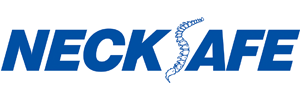NeckSafe is the technique for the Acute Management of [suspected] Spinal Cord Injuries (SCI).
These frequently asked questions address issues of neck stabilisation, devices and techniques, the NeckSafe book and the NeckSafe training course.
NeckSafe is a specific course in the Acute Management of Spinal Injuries, developed in Australia by Dr. Adrian Cohen.
NeckSafe Training should be undertaken by anyone who is likely to be the first on the scene of a suspected spinal cord injury: sports doctors, physios, trainers and support staff, ambulance officers, army medics, first aiders, general public, etc. In fact, almost everyone!!
To reduce the potential for traumatic spinal injury, first attendees to a person who has suffered a fall or a sporting injury, must “know NeckSafe”.
Moving an injured person without neck and back stabilization can lead to far more serious or fatal injury.
Awareness of how to support a person in a variety of circumstances is critical to protecting their health.
Spinal cord injury (SCI) refers to any injury to the spinal cord that is caused by trauma instead of disease. The primary causes are motor vehicle accidents, falls, sports injuries and violence.
Cervical (neck) injuries can result in full or partial tetraplegia (Quadriplegia).
To reduce the potential for traumatic spinal injury, first responders must “know NeckSafe”.
Anybody with a professional or personal interest in the health and safety of their clients, colleagues, friends or the public.
First responders, medical professionals, ambulance officers, police officers, lifeguards, sports team officials, tour guides, extreme sports competitors, and anyone else who cares!
Ambulance officers are trained in spinal management, however:
- The best ambulance response times are often in excess of 10 minutes, and maybe hours in some circumstances
- NeckSafe teaches all first responders, the critical steps in the Acute Management of Spinal Injuries
Yes, NeckSafe Aquatic training is included.
Individual circumstances may allow for specific practical assessment in these areas.
The training material and skills assessed are identical for both courses.
- NeckSafe Online eLearning training takes from 1-3 hours, depending on the user, and the student is assessed against the theory components of the course. A Competency Assessment sheet is then provided for the student’s medical director, team doctor or local authority to assess the practical competencies and sign the NeckSafe Certificate
- NeckSafe face-face training is conducted over 8 hours and all materials and equipment are provided. The NeckSafe Certificate is awarded to students deemed competent
There are several ways to undertake a NeckSafe training course:
- NeckSafe is undertaken either online via our eLearning website, or as a face-face course for a minimum of 10 people
- Online training takes from 1-3 hours, depending on the user
- The face-face course is conducted over 8 hours, or two separate 4 hour sessions (theoretical and practical)
There is no minimum requirement for re-training, but it is recommended NeckSafe training be refreshed every 3 years, to keep up with the latest developments.
The NeckSafe Course was previously accredited through NSW VETAB for over 15 years as 91515NSW Course in Necksafe..
Successful completion results in the award of the nationally recognised credential:
PUAEME004A Provide Emergency Care for Suspected Spinal Injury
- NeckSafe Online eLearning training takes from 1-3 hours, depending on the user, and the student is assessed against the theory components of the course. A Competency Assessment sheet is then provided for the student’s medical director, team doctor or local authority to assess the practical competencies and sign the NeckSafe Certificate. No equipment is necessary for the student during the online eLearning component
- NeckSafe face-face training is conducted over 8 hours and all materials and equipment are provided. The NeckSafe Certificate is awarded to students deemed competent
- NeckSafe Apps are available in Apple iTunes store and Google Play Android Store
Head immobilisers used in conjunction with cervical spinal immobilisers and spinal boards are available from many manufacturers and in many form factors.
The first consideration in which is appropriate for use in a particular circumstance is ..
Can’t find what you are looking for?
Contact us online or at 02 8007 3903

